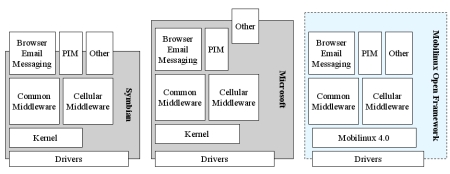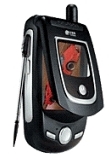Mobile Linux challenges Windows Mobile for cellphone dominance
Apr 25, 2005 — by LinuxDevices Staff — from the LinuxDevices Archive — views Taking a page from Microsoft's playbook, MontaVista today announced an embedded Linux platform aimed specifically at mobile phones. “Mobilinux” is based on a 2.6 kernel with real-time and power-management enhancements, and targets “feature-phones” as well as the higher-end devices targeted by Microsoft with its Windows Mobile for Smartphones offering.
Taking a page from Microsoft's playbook, MontaVista today announced an embedded Linux platform aimed specifically at mobile phones. “Mobilinux” is based on a 2.6 kernel with real-time and power-management enhancements, and targets “feature-phones” as well as the higher-end devices targeted by Microsoft with its Windows Mobile for Smartphones offering.
MontaVista calls Mobilinux “the first optimized OS for mobile and wireless devices that can scale from smartphones to feature-phones,” and hopes the OS's versatility will appeal to phone vendors interested in standardizing on a single OS environment across multiple segments of the phone market.
Zeroing in on feature-phones
Feature-phones — camera-phones, multimedia-phones, game-phones, etc. — are key to beating Microsoft and Symbian, MontaVista says. The company thinks the biggest opportunity in mobile phones lies in the middle ground between simple “voice phones” and complex “smartphones.” The mid-tier feature-phone market includes camera phones, gaming phones, and phones that can play music or videos, but stops short of the high-end smartphone market, comprised of phones with powerful multitasking operating systems and computer-like filesystems.
“The typical consumer doesn't want a smartphone, because they're too complex,” explains Jacob Lehrbaum, MontaVista's Product Manager for Mobile and Wireless Software. “Most users just want to make phone calls, or maybe have a few multimedia capabilities. But they want a phone that's a phone, rather than a PDA.”
According to Lehrbaum, Microsoft and Symbian either can't or have not been able to wedge their operating systems into the more resource-constrained world of feature phone hardware. “Microsoft doesn't have the performance necessary or the features necessary to get there. Symbian has more of an opportunity, and has been working on some real-time technology that they've been talking about for 12 months now, but it hasn't been adopted, and there are no handsets on the market. They haven't proven they can do it,” Lehrbaum said.
Microsoft's current mobile phone stack may not fit into feature phones; however, Intrinsyc in February previewed its own phone stack for feature phones based on the same Windows CE real-time operating system that underpins Microsoft's smartphone product.
MontaVista expects Mobilinux to appeal to phone vendors wishing to avoid the single vendor lock-in associated with Microsoft and, to some extent, with Symbian, 49 percent of which is owned by mobile phone marketshare leader Nokia. Mobilinux, in contrast, is based on open source technology that could in theory be supported or even adopted by other embedded vendors.

Unlike Symbian and Windows Mobile, Mobilinux provides a fully open framework for 3rd-party software components, MontaVista says
(Click for larger image)
Mobilinux 4.0
MontaVista chose to give Mobilinux a “4.0” version number, in its initial release, as a reflection of the product's origins in MontaVista's offering for battery-powered devices, Linux Consumer Electronics Edition (CEE) 3.1, and its less expensive, more general purpose offering, Professional Edition (Pro) 3.1, both of which have been used in mobile phone design wins. Mobilinux borrows CEE's power management technology, along with a phone-oriented subset of Pro's approximately 200 applications. Unlike the company's 3x-series distributions, however, Mobilinux includes a 2.6-series kernel with much better real-time performance, as well as a more modern C-library and compiler (glibc 2.3.3 and gcc 3.4.3), the company claims.
The real-time extensions in Mobilinux are based on technology from the “Open Source Real-time Linux Project” MontaVista launched last October. MontaVista claims Mobilinux can achieve worst-case preemption response times below 150 microseconds, and reach 100 microseconds with optimization for specific boards and drivers. By comparison, MontaVista's 2.4-series kernels have 5 millisecond performance, it says. Other commercial distributors, including LynuxWorks, have claimed significant real-time performance for their 2.6 kernels.
Cost savings
MontaVista says Mobilinux's basis in open source technology will save customers money. Additionally, the company says it will save cost by supporting single-chipset phone designs. Real-time determinism and the added performance afforded by modern compilers are central to Mobilinux's scalability, according to Lehrbaum, and will enable the embedded OS to move downmarket into phones that handle both voice and application processing on a single chipset, running a single OS, with a single bank of memory (and perhaps an external modem and DSP coprocessor).
So far, phones capable of running complex OSes like Linux, Symbian, and Microsoft have used a dual-chipset architecture. One CPU runs a real-time OS and handles voice processing, while another runs the complex OS and its applications. This dual-chipset approach has obvious drawbacks. Dual-chipset designs add a lot of cost, development overhead, and power usage. It's very costly to go that approach,” Lehrbaum said.
Single-chipset designs are pervasive in low-end voice phones, as well as in mid-market “feature phones,” including camera phones, gaming phones, and phones that play music or videos, an area representing the greatest immediate market opportunity, according to MontaVista.
Lehrbaum says mobile chipsets are shipping today that are capable of running Mobilinux in single-chipset mobile phone designs. “There are silicon options from TI, Philips, Freescale, and others. [For example], TI rolled out a product line back at 3GSM called OMAP Vox [story] which can be used as a single chipset solution.”
Increased focus on mobile devices
Interestingly, Mobilinux 4.0 is MontaVista's first Linux product offering based on the 2.6-series Linux kernel — a fact that shows just how aggressively the company is pursuing the mobile market. (The company has been slow to move to the 2.6 kernel.)
Lehrbaum declined to comment about when the 2.6 kernel would appear in MontaVista's other products, such as Consumer Electronics Edition (CEE), aimed at battery-powered devices, Carrier Grade Linux (CGE), aimed at telecom, and Professional Edition (Pro), its general-purpose product. However, he acknowledged that most of MontaVista's resources are currently being directed at the communications market. CEE, which was last updated more than a year ago, will continue to be available, but no release date has been set for a 2.6 version, Lehrbaum confirmed.
With CEE taking a back seat, Mobilinux will be the product that supports mobile devices such as portable media players, high-end cameras, gaming handhelds, and, of course, mobile phones. Non-mobile consumer devices such as IP set-top boxes, digital TVs, DVRs, and audio/video entertainment centers, on the other hand, will be covered by Pro, the least expensive MontaVista product. Lehrbaum implied that Pro would see a 2.6 update long before CEE.
Killer app?
MontaVista is clearly gambling that Linux will take off in the mobile phone space, and there are currently many indications that the company may on the right track. Linux, at least — if not Mobilinux — offers significant appeal to phone vendors. Although adoption has been slower than initially anticipated, the mobile industry's interest in Linux has been broader than many expected.
Linux's wide appeal, however, raises the question of competition not only from Microsoft and Symbian, but from other Linux vendors, including PalmSource, which recently announced that it will offer a Linux-based mobile phone platform.
Although MontaVista currently enjoys a commanding lead among Embedded Linux vendors in the mobile phone space, the race is not always to the swift. It takes more than great technology to win in the marketplace, especially against companies like Microsoft and mobile marketshare leader Nokia, which owns 49 percent of Symbian.
And, don't overlook commercial Embedded Linux's biggest competitor — in-house Linux development teams, which download kernel.org source and develop their own software platforms.
Early successes
In spite of the open source basis of its products, MontaVista believes it has a leadership position where Linux phones are concerned. The company has 11 design wins (see photos, below), and over 2.5 million phones in the field, according to Lehrbaum.










Some MontaVista Linux mobile phone design wins
Left to right: Motorola A768, E680i, E680, A760, A780; NEC N901iC, N700i, N900il; Panasonic P700i, P901i
(Click each image for further details)
Additionally, MontaVista says it is working hard to build brand and a third party ecosystem around Mobilinux, through its Mobilinux Open Framework initiative launched in February.
“[Mobilinux] is certainly built around open source technology, much of it developed in cooperation with the open source community, or contributed directly to the community by MontaVista. However, it's an actual product offering. It's not like you could go out there and download it and then you could have Wind River Mobilinux,” Lehrbaum stated.
More information about Mobilinux is available on the Mobilinux website.
This article was originally published on LinuxDevices.com and has been donated to the open source community by QuinStreet Inc. Please visit LinuxToday.com for up-to-date news and articles about Linux and open source.